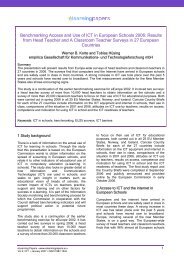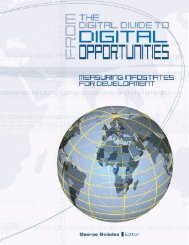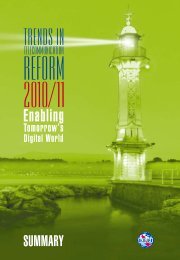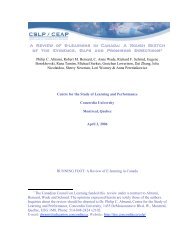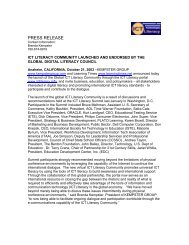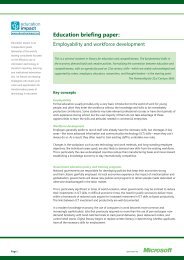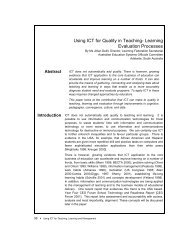The Digital Opportunity Index (DOI) - ITU
The Digital Opportunity Index (DOI) - ITU
The Digital Opportunity Index (DOI) - ITU
Create successful ePaper yourself
Turn your PDF publications into a flip-book with our unique Google optimized e-Paper software.
Statistical Chapter Three Annex<br />
Some economies are taking longer to convert their<br />
Internet subscriber base to broadband, however,<br />
especially where there is a competitive market<br />
and tariffs are relatively low. In Hong Kong SAR,<br />
the broadband market boomed after 2000 with<br />
the ratio of broadband to total Internet subscribers<br />
increasing by around one per cent a month<br />
(Figure 3.10). 30 However, broadband growth has<br />
stagnated recently and the ratio of broadband to<br />
total Internet subscribers only increased by four<br />
per cent in 2005 to 63 per cent.<br />
What explains this resistance to broadband? 31 One<br />
factor is that even though broadband prices have<br />
dropped dramatically and bandwidth has risen,<br />
dial-up is still often cheaper in many economies,<br />
particularly those, such as Hong Kong SAR, that do<br />
not charge for local calls. Also, some users do not<br />
like the always-on feature of broadband, fearing it<br />
makes them more vulnerable to cyber-intrusion<br />
(an issue examined in Chapter five). Some users<br />
simply do not need broadband since they use<br />
mostly low-bandwidth applications such as email.<br />
Finally, there are users who do not have access<br />
to broadband because they live in remote areas,<br />
outside of the range of DSL or cable. This group<br />
of users is increasingly important as one focus of<br />
debates over universal service.<br />
3.5.4 Growth in 3G mobile<br />
<strong>The</strong>re is strong growth in third generation (3G)<br />
mobile services, particularly in Asia and Europe,<br />
where nearly all the top ten largest markets are<br />
situated (Figure 3.11, left). Mobile broadband has<br />
grown in speed and by the first quarter of 2006,<br />
operators were advertising commercially available<br />
download velocities of between 384 kbit/s – 1.4<br />
Mbit/s. <strong>The</strong> industry promises even higher speeds<br />
in the future. For example, Telstra, a mobile operator<br />
in Australia claims that it will soon be providing<br />
peak network speeds of 14.4 Mbit/s over its High<br />
Speed Download Packet Access (HSDPA) network.<br />
Mobile broadband (3G) services are now offered<br />
in many developing countries throughout central<br />
and eastern Asia, Latin America and the Caribbean<br />
(Figure 3.10, right). Wideband CDMA networks<br />
were operational in 49 countries by the start of<br />
2007, with 24 HSDPA networks. Twelve economies<br />
had separate networks supporting both W-CDMA<br />
and CDMA 2000 1x in 2006. 32<br />
As operators introduce these advanced mobile<br />
services, they are now deriving a greater proportion<br />
of their revenues from data services. In Africa,<br />
data revenues are small, but growing. Vodacom<br />
Figure 3.11: Expansion of mobile broadband and 3G mobile<br />
Top ten 3G mobile markets, 2005<br />
Number of economies with mobile broadband<br />
technologies, 2001-2006<br />
Australia<br />
Portugal<br />
Spain<br />
France<br />
Germany<br />
USA<br />
UK<br />
Italy<br />
Korea (Rep.)<br />
Japan<br />
CDMA 1x EV-DO<br />
W-CDMA<br />
0 5 10 15 20<br />
79<br />
61<br />
CDMA 1x EV-DO<br />
30<br />
W-CDMA only<br />
W-CDMA+HSDPA<br />
42 20<br />
11<br />
25<br />
Total<br />
32<br />
12 26<br />
2 2 7<br />
24<br />
5 9<br />
2001 2002 2003 2004 2005 2006<br />
Source: <strong>ITU</strong>/UNCTAD/KADO <strong>Digital</strong> <strong>Opportunity</strong> Platform and <strong>ITU</strong> Internet Report 2006: digital.life.<br />
52



